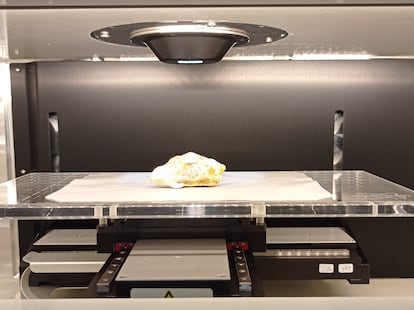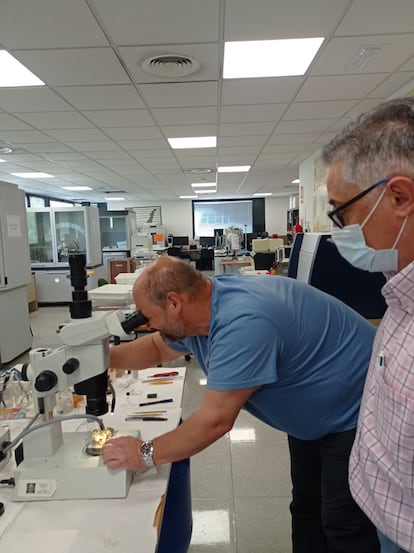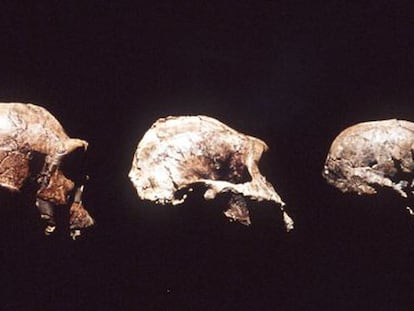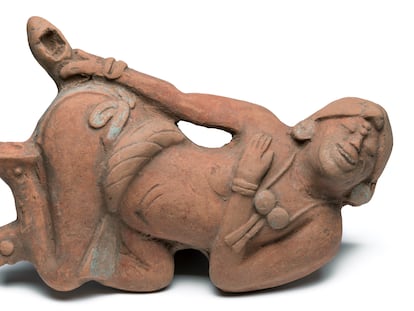How three friends in Spain discovered a heretofore unknown mineral called ermeloite
The International Mineralogical Association has recognized the new finding, which was found by amateur mineralogists on Mount Ermelo in Galicia

Mineral collectors won’t be able to display a piece of ermeloite in their showcases. The first sample weighs just a few milligrams. Found in Spain by three friends who’ve long been passionate about mineralogy, the heretofore unknown mineral was analyzed and identified at Spain’s University of Santiago Compostela.
People love minerals in a wide variety of ways, from those who adore the precious gems that can adorn their ears, to the children who save a box of the small pieces of a planet they bought at a fair. Many of those who are most enthusiastic about mineralogy may have had their interest sparked as kids that way. Such people are constantly taking samples to the USC Department of Archaeometry and Material Characterization, which has performed some 5,000 analyses over the past 20 years (as well as studies of archaeological remains).
The director of the department, Óscar Lantes Suárez, says that finding an unknown mineral “is not a question of chance.” While “you have to be lucky,” it involves “continuous work” and a dense network of “collaborators” to scour the terrain. That’s how José Carlos Rodríguez Vázquez, Moisés Núñez and Manuel Cerviño found and collected the only known sample of ermeloite, which was not registered in any international databases. The mineral was named after Spain’s Mount Ermelo, the enclave where it was discovered. “Ermeloite is a monohydrate aluminum phosphate” that belongs to the kieserite group. At first glance, it’s “easy to confuse” with other minerals, but its “structure and order,” Lantes emphasizes, are “what makes it a new type of mineral.”
Physically, ermeloite is “an externally powdery, but compact, and internally crystalline mass” of whitish color, explains the scientist, who is also the spokesman for the team who discovered the new mineral. The tiny size of the sample, which is now a specimen for national reference, has challenged researchers, and it has limited the possibilities for analyzing the mineral. For example, “ermeloite’s physical and mechanical characteristics have yet to be explored,” says Lantes. The scientists have not yet investigated how the mineral might be used, because there aren’t any other known locations of it and only a “nodule inside a pegmatite” has been found in Spain. After collecting the small sample, the three men who discovered it – all amateur mineralogists – could not find any more ermeloite on the surface. According to Lantes, it would be necessary to remove pieces of the mountain to find other small whitish nodules trapped in rocks, which “mineralogists do not do.” He says that most of these scientists “are respectful of the environment” and are content just to visit “the edges of a mine” or highway works “where there are large embankments.”

Mineralogy is like a religion, and its adherents gather at congresses, fairs and forums to exchange information. “We do the laboratory analysis,” explains Lantes, “and that requires many years of experience and skill to hone the techniques.” But, he says, many minerals reach the Archaeometry and Materials Characterization Department, “because there are people who have been collaborating with the university for a long time, people who know how to read the field very well, who know what can be found in each place and look for unusual things.”
After Rodríguez, Núñez and Cerviño collected the sample from Mount Ermelo, staff at the University of Compostela’s Research Infrastructures Department conducted X-ray diffraction analysis and confirmed that this was indeed the first discovery of the mineral anywhere in the world. Ermeloite, which has been officially recognized by the International Mineralogical Association (IMA), is the fourth mineral to be discovered in Galicia, Spain since the 19th century. The previous ones were morenosite, bolivarite and cervantite. Additionally, Lantes’s team studied ermeloite’s composition and particular characteristics using calorimetric techniques and other technologies, including X-ray fluorescence spectrometry and Raman spectroscopy. Along with scientists from Spain’s Complutense University and the Institute of Geology and Mining, they also conducted a complementary analysis of the mineral’s chemical elements.
The specimen’s small size makes it “difficult to speculate on possible industrial or technological uses,” the USC said in a press release about the finding. However, scientists have “not ruled out the possibility that this mineral’s discovery will lead to finding more in other similar environments and geological formations elsewhere in the world.” In the summer of 2023, the ermeloite sample will be featured in a Spanish mineralogical exhibit at the Fonseca (Santiago) country house. It will then be “permanently” housed at the USC’s own Museum of Natural History.
As if inspired by the ermeloite discovery, Óscar Lantes and the director of the Museum of Natural History, Marcos Andrés González, are coordinating a project called “Minerals: Seeing the Invisible” to disseminate information about mineralogical findings through the end of next year. Ermeloite’s discovery in Spain coincides with the 200th anniversary of the death of Frenchman René Haüy, the father of mineralogy and crystallography. International mineralogy has dedicated the year 2022 to Haüy, whose name is also inscribed on the second floor of the Eiffel Tower. The University of Santiago’s Museum houses Haüy’s original collection of wooden crystallographic models.
Tu suscripción se está usando en otro dispositivo
¿Quieres añadir otro usuario a tu suscripción?
Si continúas leyendo en este dispositivo, no se podrá leer en el otro.
FlechaTu suscripción se está usando en otro dispositivo y solo puedes acceder a EL PAÍS desde un dispositivo a la vez.
Si quieres compartir tu cuenta, cambia tu suscripción a la modalidad Premium, así podrás añadir otro usuario. Cada uno accederá con su propia cuenta de email, lo que os permitirá personalizar vuestra experiencia en EL PAÍS.
¿Tienes una suscripción de empresa? Accede aquí para contratar más cuentas.
En el caso de no saber quién está usando tu cuenta, te recomendamos cambiar tu contraseña aquí.
Si decides continuar compartiendo tu cuenta, este mensaje se mostrará en tu dispositivo y en el de la otra persona que está usando tu cuenta de forma indefinida, afectando a tu experiencia de lectura. Puedes consultar aquí los términos y condiciones de la suscripción digital.










































